Circle With a Thelemic Star for a Ritual Drawing
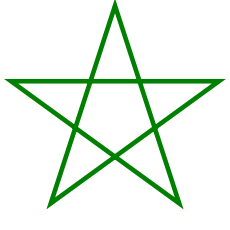
The pentagram is a figure formed using five line segments of identical length, arranged to produce five identical points surrounding a pentagram.
A pentagram, a v sided, transparent star, often inside a circumvolve, is one of the oldest markings known to humankind. Dating back to Europe equally far equally 8000 years ago, the pentagram is a symbol fraught with mystery, intrigue, and meaning. It has been the symbol of various religions and nations, from Christianity and Islam to Morocco and Federal democratic republic of ethiopia to ancient Jerusalem. In modern times, the pentagram has been used past Wiccans and distorted farther for the employ of Satanists (though 1 errs to presume a connection betwixt the two). The 5 points of the pentagram normally accept v unlike meanings; for example, for the Wiccans, the five points represent earth, sky, fire, water, and Spirit, with Spirit occupying the top and most important bespeak. Yet, these values alter from culture to culture.
Contents
- 1 History
- 1.1 Pythagoreans
- 1.ii European occultism
- 2 Geometry
- 2.1 Construction
- 2.ii Golden ratio
- 2.iii Trigonometric values
- 3 Religious symbolism
- 3.1 Christianity
- iii.2 Mormonism
- iii.3 Judaism
- iii.4 Satanism
- 3.5 Neopaganism
- iii.half dozen Bahá'í Faith
- iii.7 Thelema
- iii.8 Samael Aun Weor
- 3.9 Asia
- 4 Political symbolism
- four.ane Flags
- 5 Other organizations
- five.1 Order of the Eastern Star
- vi In Literature
- seven See as well
- 8 Notes
- 9 References
- 10 External links
- xi Credits
The pentagram has been used for a broad diversity of purposes over the course of human history. Pentagons have been used both to call forth evil and to ward it off.

A standard pentagram, enclosed inside a circle.
History
The pentagram is one of the oldest markings known to humankind, apparently discovered by astronomical research in the Tigris-Euphrates region of the Middle Eastward every bit far back every bit 6000 B.C.Due east. [1] Isolated pentagrams accept been found in Israel, in layers dating to 4000 B.C.E. [1] It then shows up among the Sumerians, with the five points believed by scholars to represent either the iv corners of the earth and "the vault of heaven," or the five visible planets of the night sky: Jupiter, Mercury, Mars, Saturn, and Venus (with Venus a representative of the Queen of Heaven). About scholars tend to dismiss the showtime theory as far fetched, just it is hard to ascertain exactly what the pentagram meant to aboriginal peoples due to the lack of thorough documentation. In fact, in that location is no clear prove on how the pentagram was used, especially after Sumer, until around 400 B.C.E. and the rise of Pythagorean mysticism.[1]
Pythagoreans
The Pythagoreans called the pentagram, ύγιεια (Hygieia) ("health;" too the Greek goddess of wellness, Hygieia), and saw in the pentagram a mathematical perfection which would later come to be known as the Golden ratio. The Pythagoreans, named and then after Pythagoras (fl 580-500, B.C.E.), a mathematician who encouraged his followers to seek out truth and knowledge, were driven hush-hush, and used the pentagram to identify themselves to each other, signing letters and communications with information technology.[2] During this fourth dimension, the pentagram represented the v points of a human being: Ii feet, ii hands, and one head, although this seems to underestimate the noesis of the Pythagoreans, every bit they were almost undoubtedly aware of its mathematical backdrop.[3]
What is known with a expert amount of certainty, yet, is that the pentagram was the main epitome in the logotype, or official seal of the urban center of Jerusalem during the flow of 300-150 B.C.Eastward. [3]
The ancient Pythagorean pentagram was fatigued with two points up and represented the doctrine of Pentemychos. Pentemychos ways "five recesses" or "v chambers," too known as the pentagonas—the five-angle, and was the title of a work written by Pythagoras's teacher and friend, Pherecydes of Syros.[4]
European occultism
Heinrich Cornelius Agrippa, amongst others, perpetuated the popularity of the pentagram equally a magical symbol, maintaining an attribution of elements (earth, burn, air, water) to the five points. Past the mid-nineteenth century, a further distinction had developed amongst occultists regarding the pentagram's orientation. With a single signal upwards, it depicted spirit presiding over the four elements of matter, and was essentially "good." Conversely, a pentagram with two points upward was considered evil. At other times likewise, especially during the Middle Ages, information technology came to represent devil worship.
A reversed pentagram, with two points projecting upward, is a symbol of evil and attracts sinister forces because it overturns the proper order of things and demonstrates the triumph of thing over spirit. It is the goat of lust attacking the heavens with its horns, a sign execrated past initiates.[5]
However, in Nordic countries (such every bit Norway and Sweden), the pentagram was used to ward off trolls and evil, in general, and was drawn on doors and walls.
Geometry
The pentagram is the simplest regular star polygon. The pentagram contains ten points (the five points of the star, and the five vertices of the inner pentagon) and fifteen line segments. It is represented past the Schläfli symbol {5/two}. Like a regular pentagon, and a regular pentagon with a pentagram constructed inside it, the regular pentagram has as its symmetry group the dihedral group of order 10.
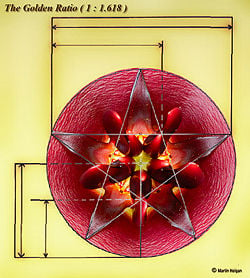
An illustration of the Golden ratio, specifically applied to a pentagram.
Structure
The pentagram can be constructed by connecting alternate vertices of a pentagon. It can also be constructed equally a stellation of a pentagon, past extending the edges of a pentagon until the lines intersect.
Golden ratio
The aureate ratio, φ = (ane+√5)/2 ≈ 1.618, satisfying
plays an of import part in regular pentagons and pentagrams. In mathematics, two quantities are in the gold ratio if the ratio between the sum of those quantities and the larger one is the same equally the ratio betwixt the larger one and the smaller. Thus, the gold ratio is approximately 1.6180339887. Each intersection of edges sections the edges in gold ratio: The ratio of the length of the border to the longer segment is φ, as is the length of the longer segment to the shorter. Besides, the ratio of the length of the shorter segment to the segment divisional past the 2 intersecting edges (a side of the pentagon in the pentagram's center) is φ. Equally the four-color analogy shows:
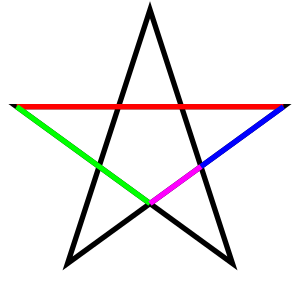
A pentagram colored to distinguish its line segments of dissimilar lengths. The four lengths are in golden ratio to 1 another.
The pentagram includes 10 isosceles triangles: V acute and v obtuse isosceles triangles. In all of them, the ratio of the longer side to the shorter side is φ. The acute triangles are golden triangles. The obtuse isosceles triangle highlighted via the colored lines in the analogy is a golden gnomon.
Trigonometric values
As a effect, in an isosceles triangle with one or two angles of 36°, the longer of the two side lengths is φ times that of the shorter of the 2, both in the case of the acute as in the example of the obtuse triangle.
Religious symbolism
Christianity
Connections between the pentagram and Christianity are many.[3] It adorned jewelry, amulets, and battle attire of early Christians, particularly before the cross was introduced. This was not just considering the pentagram was associated with the five wounds of Christ, merely likewise considering information technology could be drawn in a unmarried stroke, through one continuous motion of a pen, representing outset and end (Blastoff and Omega) equally ane.[3]
Some as well theorize that the pentagram was an expression of an early, undercover Gnostic heresy, found hidden here and at that place throughout Christianity's history, a symbol of Isis/Venus as the "secret goddess," or female person principle.[3] This symbolism normally shows upward in the Arthurian Grail romances, which many run across as Gnostic and in kabbalistic teachings bearded every bit knightly quests and their tales.[iii] For case, a pentagram appears on the shield of Sir Gawain in the fourteenth century poem, "Sir Gawain and the Green Knight."
The pentagram was embodied as a symbol of this feminine principle by the five petaled rose, constitute in many gothic cathedral ornamentations—they are truly subtle, not quite secret pentagrams.[three]
Possibly due to this, and to misinterpretation of symbols used by ceremonial magicians, the pentagram afterward became associated with Satanism and subsequently rejected by most of Christianity sometime in the twentieth century.
Mormonism
Church building of Jesus Christ of Latter-24-hour interval Saints has traditionally used pentagrams and v-pointed stars in Temple architecture, particularly the Nauvoo Illinois Temple[6] and the Common salt Lake Temple. These symbols derived from traditional morn star pentagrams that are no longer commonly used in mainstream Christianity.[7]
Judaism
The pentagram was the official seal of the city of Jerusalem during the period of 300-150 B.C.Due east. [1] Due to the similarity of the star shapes, information technology is occasionally confused with the Star of David by those unfamiliar with the symbols. In the Jewish kabbalistic tradition, the pentagram represents justice, mercy, wisdom, understanding, and transcendent splendor.[three]
Satanism
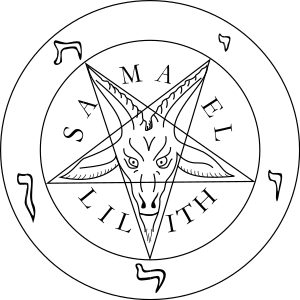
A goat's head inscribed in a pentagram, from La Clef de la Magie Noire by the Rosicrucian Stanislas de Guaita (1897).
Satanists use a pentagram with ii points upwards, ofttimes inscribed in a double circumvolve, with the head of a caprine animal inside the pentagram. This is referred to as the Sigil of Baphomet (Greek, baphe and metis, pregnant "absorption of knowledge").[2] The Pythagorean Greek letters are most often replaced by the Hebrew letters, לויתן forming the name Leviathan. Less esoteric LaVeyan Satanists use it as a sign of rebellion or religious identification, the iii downward points symbolizing rejection of the holy Trinity.
Some pinpoint this symbol's first advent to the brutal interrogations of the Knights Templar during the Christian Inquisition. However, there was no consensus as to the symbol's description.[2]
Neopaganism
Many Neopagans, especially Wiccans, use the pentagram equally a symbol of religion similar to the Christian cross or the Jewish Star of David. Information technology is not, however, a universal symbol for Neopaganism, and is rarely used by Reconstructionists.
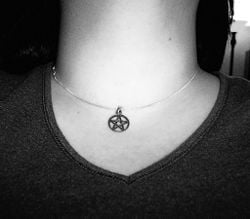
A woman wears a pentacle every bit an amulet.
Its religious symbolism is unremarkably explained by reference to the neo-Pythagorean understanding that the five points of the pentagram represent the iv elements (world, burn down, air, water) with the addition of Spirit as the uppermost point. As a representation of the elements, the pentagram is involved in the Wiccan exercise of summoning the elemental spirits of the four directions at the beginning of a ritual.
The outer circumvolve of the circumscribed pentagram is sometimes interpreted equally bounden the elements together or bringing them into harmony with each other. The Neopagan pentagram is generally displayed with ane point upwardly, partly considering of the "inverted" goat's head pentagram'south association with Satanism; however, within traditional forms of Wicca a pentagram with two points up is associated with the 2nd Caste Initiation and in this context has no relation to Satanism.
Considering of a perceived association with Satanism and also because of negative societal attitudes towards Neopagan religions and the "occult," many United States schools accept sought to prevent students from displaying the pentagram on article of clothing or jewelry.[viii] In public schools, such actions by administrators take been determined to exist in violation of students' First Amendment right to free practice of religion.[9]
Bahá'í Faith
The pentagram is the official symbol of the Bahá'í Organized religion.[10] In the Bahá'í Religion, the pentagram is known as the Haykal (Standard arabic: "Temple"), and it was initiated and established by the Báb. Both Báb and Bahá'u'lláh wrote various works in the form of a pentagram.
Thelema
Aleister Crowley also made employ of the pentagram and in his Thelemic system of magick: An adverse or inverted pentagram represents the descent of spirit into matter, not the triumph over matter which was considered evil, as taught by the Hermetic Order of the Golden Dawn.
Samael Aun Weor
Samael Aun Weor used the Pentagram to represent humanity's Atman, or Internal Christ. When a human's limbs are outstretched thus that his feet are planted on the ground while his head is situated atop his torso information technology creates the omnipotent symbol of the pentagram. Through the Mantra, "Klim, Krishna, Govindaya, Gopijana, Vallebayah, Swahah," one's inner being is said to be awakened and come to the initiate's assist. Aun Weor stated that no demon could resist the power of this mantra, since one's Logos cannot be overcome by a demon of any stature.
In contrast to representing i's Logos, the inverted pentagram represents 1's Umbral Guardian, the cancerous antonym of the divine father. Similar to many other uses of the symbol, when the pentagram'south inferior rays point upwardly, it represents Satan.
Asia
In Japanese culture, the pentagram (五芒星 gobōsei) is a symbol of magical power, associated with the onmyoji Abe no Seimei; it is a diagram of the "overcoming cycle" of the five Chinese elements, earth, air, water, forest, metal. Every bit a predominantly non-Christian land, with a different set up of associations fastened to the symbol, in that location is no social stigma associated with it.
Political symbolism
Flags
While a solid five-pointed star is found on many flags, the pentagram is relatively rare. Information technology appears on two national flags, those of Ethiopia and Morocco, and in some coats of arms.
According to Ivan Sache, on the Moroccan flags, the pentagram represents the link between God and the nation.[xi] It is likewise possible that both flags use the pentagram as a symbol of Male monarch Solomon, the archetypal wise king of Jewish, Christian, and Muslim lore.
Other organizations
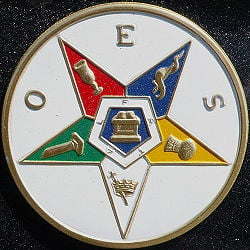
Social club of the Eastern Star symbol.
Lodge of the Eastern Star
The Order of the Eastern Star, a fraternal system associated with Freemasonry, has employed a bespeak-down pentagram as its symbol, with the five isosceles triangles of the points colored reddish, blue, yellowish, white, and light-green. This is an older form of the order's emblem and it is now more normally depicted with the primal pentagon rotated 36° and so that information technology is no longer strictly a pentagram.
In Literature
In Goethe's Faust, the pentagram prevents Mephistopholes from leaving a room.
- Mephistopheles:
- I must confess, my stepping o'er
- Thy threshold a slight hindrance doth impede;
- The sorcerer-foot doth me retain.
- Faust:
- The pentagram thy peace doth mar?
- To me, thou son of hell, explain,
- How hostage thou in, if this thine exit bar?
- Could such a spirit cypher ensnare?
In American gothic fiction writer H. P. Lovecraft'southward Cthulhu Mythos stories, the version of The Elder Sign devised by August Derleth is a warped pentagram with a flaming center or pillar of flame in the center. It was first described in Derleth's novel, The Lurker at the Threshold. (This was, however, different from the symbol that Lovecraft himself had envisaged.)
In Dan Chocolate-brown's novel The Da Vinci Code, the pentagram represents the planet Venus, based on the successive inferior conjunctions of Venus against the Zodiac.
See also
- Polygon
- Star of David
- Symbol
Notes
- ↑ 1.0 i.1 1.2 1.three Symbols.com, Pentagram, Symbols.com. Retrieved August 9, 2014.
- ↑ 2.0 ii.1 2.2 Symbols of Wicca, other Neopagan traditions, Satanism, etc., Religious tolerance.org. Ontario Consultants on Religious Tolerance. Retrieved August ix, 2014.
- ↑ 3.0 3.1 iii.2 3.3 iii.iv 3.five three.vi 3.7 The Pentagram in Depth, SymbolDictionary.net. Retrieved Baronial 9, 2014.
- ↑ Thou. S. Kirk and J. Due east. Raven, The Presocratic philosophers; a critical history with a selection of texts. (Cambridge, Britain: University Press, 1957, ISBN 9780521274555), 55
- ↑ Éliphas Lévi. Transcendental magic: its doctrine and ritual. (London: Bracken, 1995, ISBN 9781858913797).
- ↑ Marshall University, Nauvoo Temple. Retrieved July 20, 2008.
- ↑ Matthew B. Brown, Inverted Stars on LDS Temples, The Foundation for Apologetic Information and Research, Retrieved July 20, 2008.
- ↑ B. A. Robinson, Religious Habiliment & Jewelry in Schoolhouse, Religious tolerance.org. Ontario Consultants on Religious Tolerance. Retrieved July 20, 2008.
- ↑ Associated Press, May 1, 2000, Federal estimate upholds Indiana students' right to article of clothing Wiccan symbols, Beginning Amendment Heart, Retrieved July 20, 2008.
- ↑ Bahá'í Reference Library, 141: NINE (Number), Directives from the Guardian, (Bahá'í International Community), 51-52, Retrieved July 20, 2008.
- ↑ Flags of the World, Moroccan flag, Flagspot. Retrieved July 20, 2008.
References
ISBN links support NWE through referral fees
- Grünbaum, B. "Polyhedra with Hollow Faces," Proc of NATO-ASI Conference on Polytopes, Edited by T. Bisztriczky et al. Kluwer Academic, 1994, 43-70. OCLC 197470331
- Grünbaum, Branko, and Yard. C. Shephard. Tilings and patterns. A Serial of books in the mathematical sciences. New York: W.H. Freeman, 1987. ISBN 978-0716711933.
- Kirk, Chiliad. S., and J. E. Raven, The Presocratic Philosophers: A critical history with a option of texts. Cambridge, UK: Academy Press, 1957, ISBN 978-0521274555.
- Lévi, Éliphas. Transcendental magic: its doctrine and ritual. London: Bracken, 1995, ISBN 978-1858913797.
External links
All links retrieved Feb iv, 2019.
- Eric Due west. Weisstein. Pentagram. MathWorld—A Wolfram Web Resource.
- Apollonios Sophistes. The Pythagorean Pentacle. Biblioteca Arcana.
- Mark Freitag. In-depth analysis of the Golden Ratio, Professor Jim Wilson's Mathematics folio, Academy of Georgia.
- M Lodge of British Columbia and the Yukon. The pentagram and Freemasonry.
Credits
New Earth Encyclopedia writers and editors rewrote and completed the Wikipedia commodity in accordance with New World Encyclopedia standards. This article abides by terms of the Creative Commons CC-by-sa 3.0 License (CC-by-sa), which may be used and disseminated with proper attribution. Credit is due nether the terms of this license that can reference both the New Globe Encyclopedia contributors and the selfless volunteer contributors of the Wikimedia Foundation. To cite this article click here for a list of acceptable citing formats.The history of before contributions by wikipedians is accessible to researchers here:
- Pentagram history
The history of this article since information technology was imported to New World Encyclopedia:
- History of "Pentagram"
Notation: Some restrictions may apply to apply of individual images which are separately licensed.
Source: https://www.newworldencyclopedia.org/entry/pentagram














0 Response to "Circle With a Thelemic Star for a Ritual Drawing"
Publicar un comentario